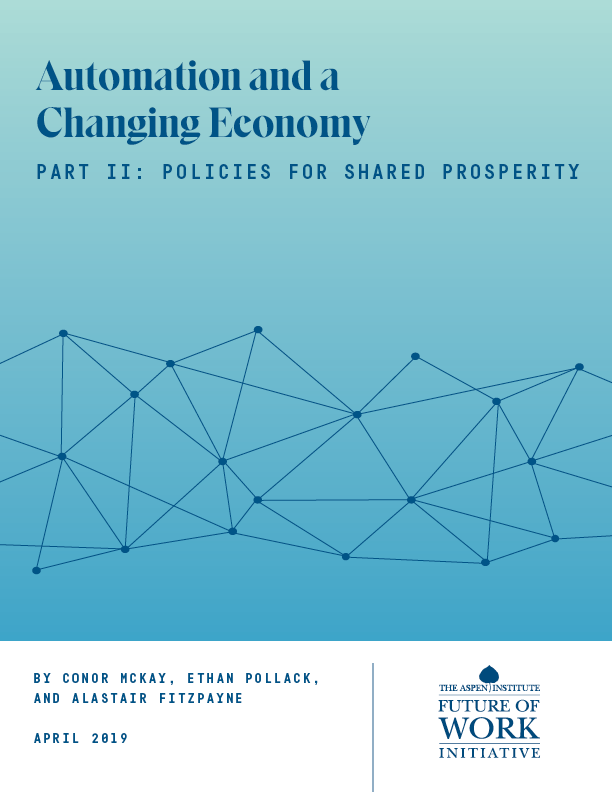Automation and a Changing Economy is divided into two sections. Part II, Policies for Shared Prosperity, outlines a program to address automation’s challenges and opportunities.
Introduction
Part I of this report, Automation and a Changing Economy: The Case for Action, explores how automation has impacted and will continue to impact the economic security and opportunity of the American worker.
But technology is not destiny. The impact of innovation on the American worker is mediated by policies and institutions. We can choose to create an economy that:
- promotes technological progress;
- prepares workers to take advantage of the opportunities technology presents;
- supports those who are negatively impacted by automation return to stable work; and
- shares technology’s gains more broadly.
These goals are achievable with the right support, but the policy structures currently in place are inadequate.
This part of the report, Automation and a Changing Economy: Policies for Shared Prosperity, outlines a policy agenda for addressing these challenges and opportunities. Doing so requires an all-of-the-above approach, from targeted, specialized interventions to those with systems-level impact; from place-based policies to national-level reforms to safety net programs. The paper identifies four objectives that guide its recommendations:
I. Encourage Employers to Lead a Human-Centric Approach to Automation
CHALLENGE: Automation changes workforce skill needs, yet employer investment in workforce development has declined.
- Solution: Promote employer engagement and investment through a worker training tax credit, expansion of apprenticeships, and new sector and regional workforce partnerships.
CHALLENGE: Employers are making decisions about adopting automation, but may not take into account potential impacts on workers and communities.
- Solution: Encourage employers to adopt a multi-stakeholder approach to automation decisions by promoting new forms of worker voice and ownership and developing proactive strategies to identify and address impacts in advance.
II. Enable Workers to Access Skills Training, Good Jobs, and New Economic Opportunities
CHALLENGE: The labor market is constantly evolving, with automation contributing to changing jobs and skill needs, but supports for worker training and adult education are limited.
- Solution: Improve access to effective and affordable skills training and develop a culture and system of lifelong learning.
CHALLENGE: Many workers struggle to make ends meet, and while automation has the potential to improve job quality, it also may lead to more low-wage jobs and greater economic insecurity.
- Solution: Increase wage subsidies and the minimum wage, while creating more economic opportunities by improving labor market flexibility and promoting entrepreneurship.
III. Help People and Communities Recover from Displacements
CHALLENGE: Workers displaced by automation face significant economic challenges.
- Solution: Strengthen supports for unemployed workers through retraining, reemployment services, and Unemployment Insurance to help displaced workers transition to new jobs and careers.
CHALLENGE: Communities that are severely impacted by automation require targeted and comprehensive strategies to recover and transition.
- Solution: Support local economic development and improve regional competitiveness through sector-based development strategies and investment in digital infrastructure.
IV. Understand the Impact of Automation on the Workforce
CHALLENGE: Policymakers, communities, workers, businesses, educators, and other stakeholders struggle to understand how automation is changing the economy because federal, state, and local data on the impact of technology on work is inadequate.
- Solution: Provide key stakeholders with better information on the impact of automation by collecting data on technological advancements, adoption rates, and workforce impacts.
These proposals offer a broad range of ideas that speak to several parts of the opportunity and challenge of automation, but they are not exhaustive. Much more will need to be considered and pursued. Some ideas are tested and proven, ready to be taken to scale. Others are still being developed, requiring experimentation and rigorous evaluation. Though each proposal can and should be considered on its own merit, many proposals—such as those to improve training access, availability, and quality—complement one another, and taken together form the contours of a comprehensive agenda for responding to the challenges and opportunities posed by automation. To be sure, there are many critical issues affecting the economic security of the American worker that deserve attention and action. This agenda should therefore be considered as an important component of the broader need for policies that create opportunity and value work in the 21st century.
This agenda focuses largely on policy solutions. These challenges, however, cannot be overcome solely by government, and certainly not by national policymakers alone. The challenge of automation requires action from federal, state, and local policymakers to employers, worker organizations, education and training providers, civil society organizations, and community leaders.
Read Part II: Policies for Shared Prosperity



